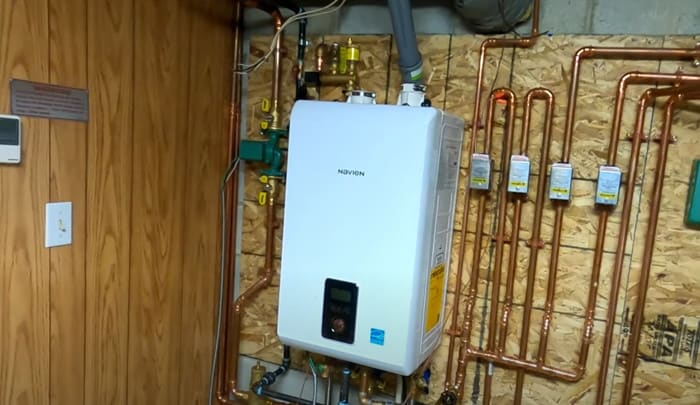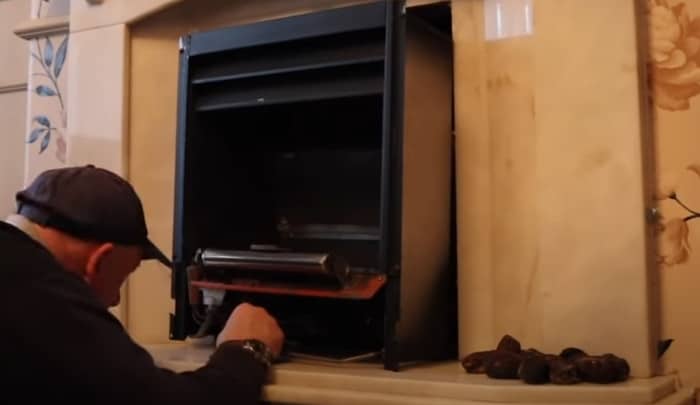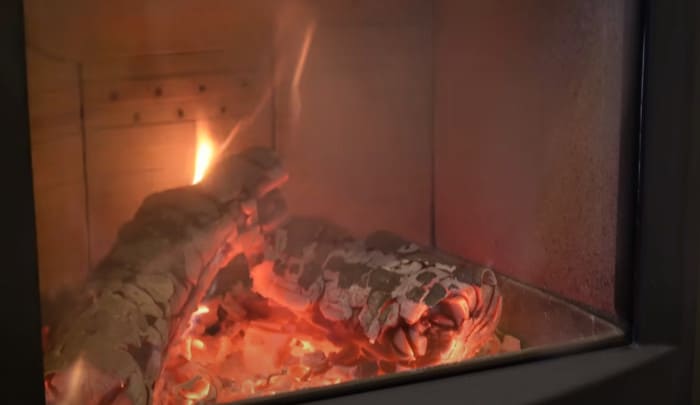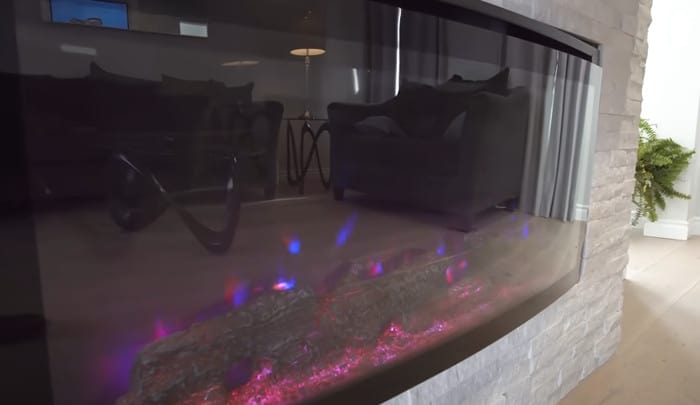It is indubitable that electric fires can add a cozy touch of warmth in any cold room. However, if you want a more contemporary style and are looking to save some money on fuel bills, why not consider an electric fire? These modern heating solutions offer both style and efficiency
? Installation of an electric fire in front of a back boiler is something that many homeowners across the UK have been contemplating recently. But is it really possible to install an electric fire in front of a back boiler without any difficulties?
In this blog post, we will explore the possibilities of installing an electric fire in front of a back boiler, what you need to know before you go for this installation, and the safety aspects associated with it. We’ll also discuss whether electric fires are expensive to run and maintain. So, if you have your heart set on this unique and budget-friendly style of heating up your home, you will find all that you need to know right here. So, let’s briefly discuss the concept and see what’s possible.
- Is it Legal to Install an Electric Fire in Front of a Back Boiler?
- Is it Safe to Install an Electric Fire in Front of a Back Boiler?
- Are There Any Alternatives to Installing an Electric Fire?
- Can a Gas Fire or Log Burner be Inserted in Front of a Back Boiler?
- What Other Ways Can You Heat a Room or Space?
- Conclusion
- Answers to Frequently Asked Questions
- References
Generally speaking, it is not advisable to put an electric fire in front of a back boiler. This could potentially lead to the build-up of dangerous gas fumes, which could be harmful to your health.
“Installing an electric fire in front of a back boiler is indeed a very plausible option, as long as it’s executed correctly. The key here is to ensure that the electric fire is fitted professionally and that the heat produced doesn’t interfere with the back boiler’s operations. It’s also worth considering quiet electric fireplaces for a more peaceful ambiance. This might require utilizing a heat shield or similar protective measures. Trustworthy professionals with experience in this field understand these nuanced technicalities and the importance of adhering strictly to safety regulations.”
Harrison Proctor, Certified HVAC Engineer
Is it Legal to Install an Electric Fire in Front of a Back Boiler?
Installing an electric fire in front of a back boiler is a controversial issue. Though there may be benefits, safety regulations are a priority for everyone involved. It is important to understand the potential risks and dangers, as well as the legal implications associated with this procedure.
For one, an electric fire should never be installed in front of a back boiler if it could potentially interfere with the ventilation. This is partially why most people concerned about safety recommend a balanced plenum between the two systems instead. A blockage of air flow puts both units at risk for damage, as well as creating an environment that could easily become dangerous for those living in the home.
Another concern when installing an electric fire in front of a back boiler is caused by the low temperatures created by the electric fire mixture, which can cause cold spots on flues and gas pipes. This becomes especially problematic when dealing with high energy appliances. Without proper and adequate insulation, pipes can become frozen or corroded quicker than normal due to extreme temperatures changes, leading to water damage or fire hazards if not properly handled ahead of time.
It is also illegal to install an electric fire in front of a back boiler without permission from your local Building Control/Planning Department. The law requires that all such works must have prior approval before they can be carried out. The building regulations consist of regulations in which all new building work must comply with in order to provide adequate health and safety protection for those using the building it was constructed for. Most likely a Building Inspector will need to view any proposed works before works commence on site to check for compliance with these regulations.
In summary, installing an electric fire in front of a back boiler can be done safely if all safety precautions are taken into consideration; however, it is important to note that any such installation does need approval from local planning authorities before it can be executed in line with local building regulation rules and laws. Understanding both sides of this argument ensures that homeowners are informed when deciding whether or not to make alterations or upgrades to their homes involving an electric fire installation. With that said, it is time to turn our attention towards building regulations which will govern any future installations involving the use of an electric fire and a back boiler system together.

Building Regulations
When installing an electric fire in front of a back boiler, it is important to take the relevant building regulations into account. This is even more pressing considering the potential risks associated with such a combination. Depending on where you live, there may be different regulations specifying how far the fire should be positioned from the existing boiler.
In UK and EU countries, the only regulation that specifically addresses this is known as Building Regulation 7 (BR7). The current version requires that any appliance requiring electricity must be installed at least 500 millimeters away from any combustible material. It also states that non-electrical heaters must not come closer than 300 millimeters to an electrical heater. Therefore, if using an electric fire in front of a back boiler, the space between them needs to comply with both parts of this regulation.
The BR7 regulation doesn’t apply to all locations so further research may need to be done to correctly assess the regulations that are applicable. Additionally, some local authorities may have specific regulations for their area so it is advisible to check with them before proceeding with any installation work.
Another consideration is domestic appliance fittings near a boiler – depending on your location, some guidelines may apply in regards to placement and access points. Again, these can vary hugely by region so searching online and contacting your local authority should provide you with further information.
Finally, you should seek out advice from professional gas safety engineers or other experts who can evaluate whether or not the installation complies with local building regulations.
Overall, ensuring compliance with building regulations before starting any installation of an electric fire in front of a back boiler is essential in order to ensure safety and legality of the project. With this in mind, it’s now time to consider whether or not this combination of appliances is in fact safe: Is it Safe to Install an Electric Fire in Front of a Back Boiler?
Is it Safe to Install an Electric Fire in Front of a Back Boiler?
Installing an electric fire in front of a back boiler carries certain risks, and the decision to do so should be made with caution. There is the potential for damage to both the fire and the boiler, as well as other nearby objects such as furniture. It’s important to consider factors such as the type of existing heating systems, the age of the system and appliances, as well as any existing safety regulations.
Aside from potential damage or injury caused by improper installation, there is also a risk of fire. In order to ensure safety, all relevant safety precautions must be taken when installing an electric fire in front of a back boiler. This includes checking that all combustible materials are kept away from the fire and that it is installed correctly according to manufacturers’ instructions. It’s important to also check that no combustible material is situated within 600mm either side of the fire in order to minimise risk. Additionally, it’s worth considering whether insulation like vermiculite needs to be included behind the electric fire to protect surrounding materials from heat radiation.
The risks of installing an electric fire in front of a back boiler must be weighed against the potential benefits. However, if these risks can not be managed in a safe and responsible way, then it is probably best not to install an electric fire in this manner.
The next section will cover “Risk of Fire” and explain why it is important to some individuals for whom this installation option may seem more appealing than installing an oil or gas heater.

Risk of Fire
It is essential to be aware of any risks associated with installing an electric fire in front of a back boiler. There is the risk of overloading the circuit, as well as the possibility that the fire will become hot enough to damage the back boiler, or even catch it alight. The main safety concerns from any kind of fire installation is the potential risk of fires starting. This can partly be addressed by making sure there are suitable fire barriers and operational systems in place, but this will not completely eliminate all risks of fires occurring.
When an electric fire is installed near a back boiler unit, it is highly important to keep combustible material away from it, and make sure that no flammable chemicals are present. Any direct contact between the fire and combustibles should be avoided, and all necessary surface temperatures should be monitored regularly. It may also be beneficial to install automatic cut off systems if necessary, as this will prevent any damages occurring due to sustained high temperatures.
On the other hand, some argue that electric fires come with built-in safety features that minimise the risk of fires starting, and provide users with peace of mind. They work using a closed system, meaning there is very little chance for anything external to cause a fire due to sparks or plastic melting. Additionally, most models have thermostats fitted so they will not exceed their safe operating temperature limit before automatically shutting off.
Overall, there is potential risk when installing an electric fire in front of a back boiler unit and appropriate measures should be taken to ensure this is mitigated as much as possible. In order to do this effectively it is important to consider both the positives and negatives associated with such installations and take any steps necessary to protect against any potential dangers.
Next we will explore whether there are any alternatives to installing an electric fire in front of a back boiler unit.
Main Takeaways
Installing an electric fire in front of a back boiler can pose safety issues as it could overload the circuit, become hot enough to damage the boiler, or catch fire. It is important to keep combustibles away from the fire and install automatic cut off systems if necessary. Some argue that electric fires have built-in features like a closed system and thermostats that can help reduce risk. However, it is important to weigh the positives and negatives of such an installation before proceeding. Alternatives will be explored next.
Are There Any Alternatives to Installing an Electric Fire?
There are a couple of alternatives to installing an electric fire in front of a back boiler. First, you can simply remove the fire insert and leave just the back boiler as your main source of heat. Many homeowners choose this option because it is simpler and more cost-effective than replacing or installing a new fire. But be aware that without the assistance of a fire, you may not benefit from any additional warmth or heat increase in the room.
The second alternative is to install radiant panels. Radiant panels are an efficient and affordable way to supplement the existing heating system, by using electrical current running through special panels, these generate heat which radiates through the walls and into the living space. While they may not have as much aesthetic appeal as an electric fire, they do provide a reliable source of warmth and ambiance in the room in which they are installed.
For those who still want to keep their fire insert intact and working, a third option is to replace it with a gas fire or log burner. This ensures that not only do you receive all of its benefits in terms of aesthetics and home comfort, but also that you benefit from efficient heating when combined with your existing back boiler system. The next section will focus on how one can go about installing a gas fire or log burner in front of a back boiler.
Next up, we will discuss how to go about installing a gas fire or log burner in front of a back boiler should you decide to take this route..
Can a Gas Fire or Log Burner be Inserted in Front of a Back Boiler?
When considering whether to install a gas fire, log burner, or other heat source in front of a back boiler, the complexity of the installation is important. While most gas appliances can be installed relatively easily in front of an existing back boiler system (usually with the assistance of a qualified engineer), some may require more complex installation procedures due to the need for additional ventilation and access points. Therefore, before deciding on which type of heating appliance to purchase, it’s important to understand how it will fit into existing systems.
Log burners are usually considered the easiest option when installing a new heat source in front of a back boiler. Simply put, these are designed to sit on top of the existing boiler without requiring any additional plumbing work. As long as all safety regulations are observed, providing that there is adequate space for the burner, installing one should be relatively straight-forward. However, it’s important to consider the flueing requirements for any log burning appliances in order to ensure that hazardous fumes from combustion can be safely vented, as specified by building regulations and your local authority.
Gas fires are typically more difficult to install than log burners because they normally require more complicated venting arrangements plus access points for electrical and gas supplies. Due to their complexity and the more involved safety regulations associated with gas fire installation processes, it’s generally recommended that only an experienced gas engineer carries out such work.
Overall, when considering whether or not a gas fire or log burner can be inserted in front of an existing back boiler, it is important to seek expert advice first and make sure you understand all relevant regulations specific to your particular situation before proceeding with any installation work.
What Other Ways Can You Heat a Room or Space? This section will examine the variety of heating options available – including both traditional and modern technology – that can be used effectively in any room or space.

What Other Ways Can You Heat a Room or Space?
Heating a room is an important factor when it comes to creating a comfortable living space. There are several ways to do this, some of which include electric heaters, furnaces, and boilers. Each has its own pros and cons, so it’s important to consider the unique needs of each room or space when deciding which option to choose.
Electric heaters are a popular choice for individuals looking for supplemental heating in particular spaces. These units are relatively easy to install, require little maintenance, and can quickly and efficiently raise the temperature in a localized area. On the downside, electric heating can be costly, as it depends on electricity prices in order to determine its cost-efficiency.
Furnaces are another option for those who want more centralized heating for their homes. Furnaces require ductwork for installation and can last up to 15 years if properly maintained. They tend to provide consistent heating that warms an entire home evenly throughout all levels. The main drawback of furnaces is the price tag associated with installing them, particularly when replacing existing equipment.
Lastly, boilers offer an energy-efficient option both as supplemental heating units or complete home solutions. Boilers are versatile enough to be used with multiple types of fuel and provide uniform heating throughout a residence, making them a great choice for those looking for customized warmth during cold weather months. On the flip side, boilers require more time and effort when it comes to installation and may require specialized technicians or materials to maintain.
No matter what type of heating system you decide is right for your space or home, it’s important to consider all variables when making a decision—including efficiency ratings and areas needing coverage—to ensure an optimal outcome.
With that said, it’s important to understand the different options available before drawing a conclusion regarding what type of heat source works best for any given situation. In the next section we will review how one can confidently make such decisions by covering some tips and considerations when installing an electric fire in front of a back boiler. Conclusion: In the next section we will review how one can confidently make decisions about what type of heat source works best by covering some tips and considerations when installing an electric fire in front of a back boiler.
Conclusion
The main takeaway when considering whether to install an electric fire in front of a back boiler is that it is possible and may be the best solution for some households. Installing an electric fire in front of a back boiler requires significant effort and special considerations, such as adequate ventilation and extended mains cable runs. There are also potential fire risks with this type of installation, which should be taken into account.
It is not always necessary or economically viable to install an electric fire in front of a back boiler, however. For many people, the existing (and often more efficient) gas fires already in place provide adequate heating needs. Furthermore, if a chimney is unavailable or inaccessible for use with a gas fire, then other options such as fan-assisted convection heaters should be considered instead. It’s important that whatever option you choose fits within your budget and provides the necessary necessary heating requirements safely and efficiently.
Ultimately, each household’s decision whether to install an electric fire in front of a back boiler will come down to their individual circumstances. If you decide to go ahead with this option, it is essential that you seek professional advice beforehand to ensure that all safety measures are met and that it meets your budget.

Answers to Frequently Asked Questions
What are the potential risks of installing an electric fire in front of a back boiler?
The potential risks of installing an electric fire in front of a back boiler are numerous. The most common risk is a fire hazard due to increased heat from the combustion chamber within the back boiler, which can cause anything combustible in close proximity to ignite. Additionally, poor insulation or installation of the electric fire can lead to electric shocks if the materials become too warm and short out. If not installed properly, dust and ash particles may become trapped around the back boiler, resulting in an increase in your already existing home fire risk. Furthermore, there is a potential risk of carbon monoxide poisoning, which should be monitored if an electric fire has been installed in front of a back boiler. In short, while electric fires are generally considered safe to use, extra precaution should be taken when installing one in front of a back boiler.
Are there any special considerations to keep in mind when installing an electric fire in front of a back boiler?
Yes, there are a few special considerations to keep in mind when installing an electric fire in front of a back boiler. Firstly, the back boiler should be large enough to accommodate both the boiler and the fire. Secondly, it is important to maintain sufficient clearances between the boiler and fire so that they do not overheat and cause damage to each other or risk a fire hazard. Additionally, you should ensure that any combustible materials (wood, plastics) used to operate or support the stove are kept away from the boiler. Furthermore, the flue connecting the two devices should be checked periodically for blockages due to debris or condensation build-up. Finally, checking local building codes and regulations before installation is important as some areas may require additional safety measures.
What requirements must be met for a safe back boiler installation?
In order for a back boiler installation to be safe, it is important to ensure that the system being installed complies with current building regulations. This includes getting professionally fitted, having adequate ventilation and ensuring that partitions are in place to prevent flue gases from entering the living space. Additionally, gas safety regulations must be followed closely and the appliance must be regularly serviced by a qualified technician. As with any other heating system, it is also crucial that the fire is correctly sized and matched to the output of the back boiler in order to safely heat the required area. Finally, all electrical connections must also be in accordance with current regulations as well as being properly maintained.
References
https://www.evergreenenergy.co.uk/sustainable-home/top-4-alternatives-gas-boilers/
https://www.direct-fireplaces.com/resources/gas-or-electric-fires-which-is-best/





I remember once working on a project where we tried to integrate an electric fire in front of a back boiler and let me tell you, it was no walk in the park. Precision handling was crucial to avoid damage to both appliances. It’s not impossible, just needs careful planning and experienced execution. I’d suggest getting a professional to do it unless you have substantial experience with electrical appliances.
Following up on Vincenzo’s comment, the installation does indeed call for a very high degree of precision as even a small mistake can lead to significant damage. I recall vividly the second time I attempted to install an electric fire in front of a back boiler, let me tell you, it was incredibly nerve-racking although the outcome was successful. Despite my exquisite technical skills, I was quite literally holding my breath the entire time. So, let it be said, this is certainly something for the seasoned DIY veterans or those with a trained professional at hand.
Echoing what Graydon said, the element of precision is indeed a non-negotiable requirement for this task. Back in 2019, I furnished my country cabin with an electric fire and I must admit, it came with its own set of challenges, even for an experienced handyman like myself. I would strongly recommend going for professional assistance with such delicate projects, as any slight error can be detrimental to the boiler’s integrity and overall system health.
I concur with you, Lucius. Even with my extensive experience in the field, I still found the installation process of electric fire over back boiler challenging; any misstep can potentially compromise the unit’s efficiency or worse, pose safety risks.
You’re spot on, Quinton Pythagoras. Any lackadaisical approach to such installations could indeed bear heavy consequences. In my working years, I’ve seen what cost-cutting measures or a hurried job can lead to; we really need to accord due diligence and time while engaging with tasks like these.
From my engineering days, I remember how critical the installation process for such units can be. Even the slightest error or negligence can lead to systemic failures and safety hazards that are not worth the risk.
You’re absolutely right, Lavender; even a minute error during installation can spell catastrophe. It’s non-negotiable that everyone involved follows stringent safety protocols to avoid any mishaps. I emphasise this to all our engineers and trainees – a back boiler, just like any other complex equipment, should be handled with the utmost care for both personal safety and system integrity.
While I concur with you Jamison about the diligence required in handling complex equipment like the back boiler, I’d add that installing an electric fire is like changing the engine while the car is still running; it not only needs expert hands but a strategic plan to ensure seamless execution without causing any harm.